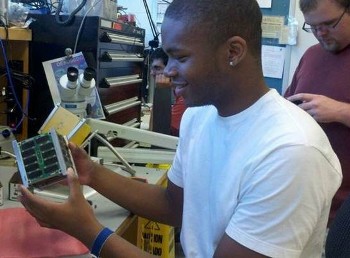Mar 30 2013
A Penn State project is one of 24 small satellites selected by NASA to fly as auxiliary payloads planned for launch between 2014 and 2016, the agency recently announced.
 Aerospace engineering senior Andre Coleman Jr. serves as the thermal subsystems lead for the Penn State OSIRIS nanosatellite mission, slated to be launched by NASA between 2014 and 2016. Image: Sven Bilen
Aerospace engineering senior Andre Coleman Jr. serves as the thermal subsystems lead for the Penn State OSIRIS nanosatellite mission, slated to be launched by NASA between 2014 and 2016. Image: Sven Bilen
The tiny satellites, known as CubeSats, are 4 by 4 inches on each side, have a volume of approximately 1 quart and weigh less than 3 pounds. The nanosatellites are used for research, educational missions and technology demonstrations.
Penn State's effort is called the Orbital Satellite for Investigating the Response of the Ionosphere to Stimulation and Space Weather, or OSIRIS-3U.
Sven Bilén, head of the School of Engineering Design, Technology and Professional Programs and adviser to the Student Space Programs Laboratory (SSPL), said, "Being provided a launch opportunity for OSIRIS-3U is extremely rewarding. SSPL has always been focused on providing students with hands-on opportunities to learn space systems engineering, and launching our CubeSat and collecting data from it in space will be a rich learning experience for all involved."
Tim Brubaker, a senior in electrical engineering and SSPL manager, explained, "The OSIRIS mission is an investigation into space weather phenomena. As our infrastructure becomes dependent on space-based systems such as communications satellites, space weather such as geomagnetic storms and solar flares are able to disrupt daily operations. What does this mean to people? We all rely on the power grid, cellphones and, indirectly, GPS."
The project will investigate where plasma goes when high-power radio waves cause large ionospheric "bite-outs," or drops in electron density, in the ionosphere's F region, which begins approximately 120 miles above sea level.
The F region is used to reflect radio signals and is especially critical in propagating high-frequency (HF) radio waves used by airplanes for air-to-ground communication, ships for sea-to-shore communication, over-the-horizon radar systems, military and governmental communication systems, shortwave radio broadcasting and amateur radio operators.
"Communications and GPS satellites must withstand space conditions, but it may come as a surprise that the power grid can also be influenced by geomagnetic storms," Brubaker stated. "Intense storms can couple currents into the power grid and melt large transformers, leaving millions without power."
More than 30 undergraduate and graduate students are involved in OSIRIS, said Andre Coleman Jr., a senior in aerospace engineering who serves as the thermal subsystem lead. He added that team members represent majors across science, technology, engineering and mathematics.
Instruments on board the OSIRIS include a Langmuir probe, a GPS radio occultation receiver from The Aerospace Corp. and a coherent electromagnetic radio tomography radio beacon from the Naval Research Laboratory.
"In order to better understand space weather, we turn to high power transmitters to heat the ionosphere and create artificial weather," Brubaker explained. "The primary research goal of OSIRIS is to characterize these events by flying through the heated region of our ionosphere. Results of the mission, beyond understanding radio-wave interaction with the ionosphere, can be used for research into space weather forecasting and for developing countermeasures to prevent damage to our infrastructure."
Coleman said, "It’s a learning opportunity for the next generation of great scientists and engineers."
Coleman, whose responsibilities include generating thermal simulations of the CubeSat in orbit, designing heater circuitry to protect components during the mission and testing OSIRIS at the temperatures it's expected to meet, added, "From working on this project, I have learned what personnel, expertise and effort are required for a significant aerospace engineering project to be successful."